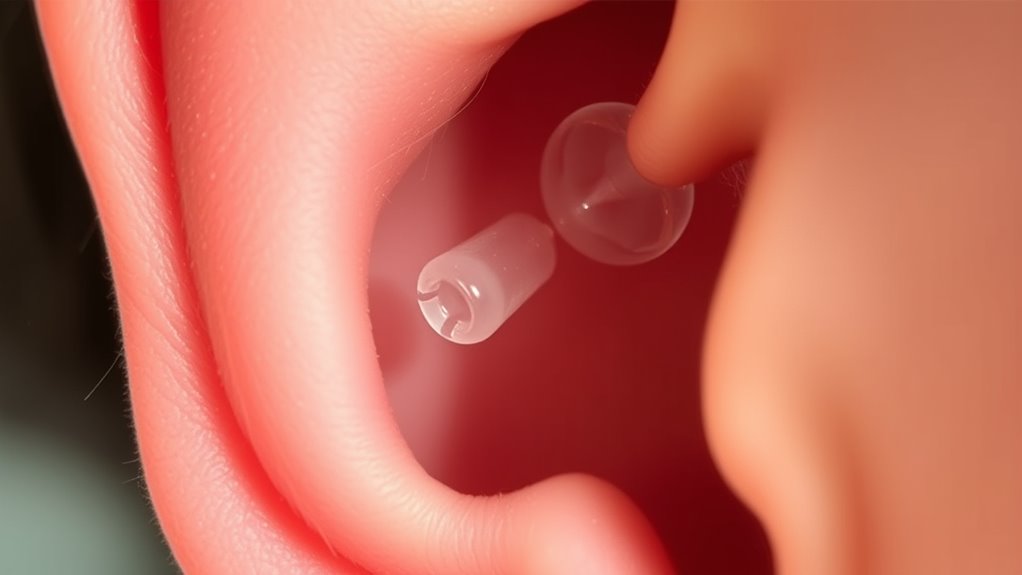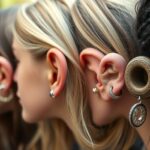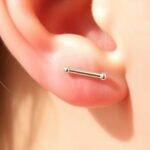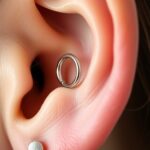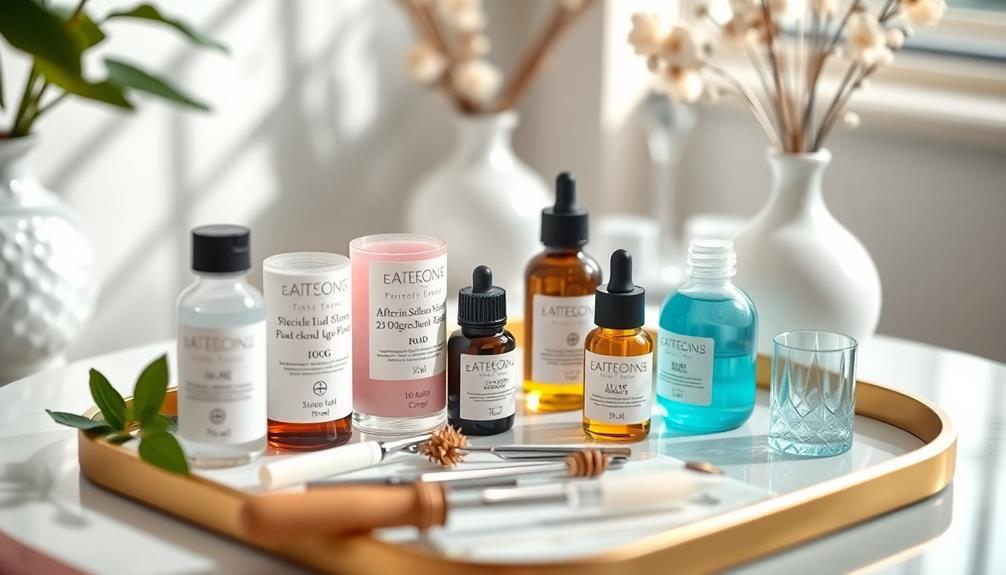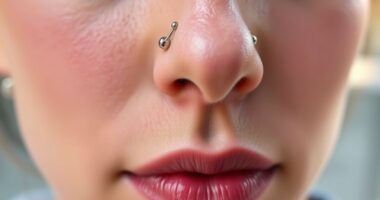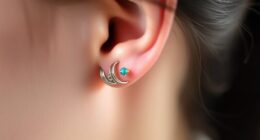To safely stretch your earlobes, take your time and listen to your body. Wait at least 4-6 weeks between stretches, ensuring proper healing to prevent tearing or infection. Use high-quality, hypoallergenic jewelry, and keep your ears clean with saline solution. Avoid rushing or forcing steps; gradual stretching reduces risks and promotes healthy growth. If you want to learn more about effective and safe gauging methods, keep exploring for detailed tips.
Key Takeaways
- Wait at least 4-6 weeks between stretches to allow proper healing and reduce tissue damage.
- Use gradual, consistent stretching techniques with appropriate jewelry to minimize trauma.
- Keep ears clean with saline or gentle antiseptics, avoiding harsh chemicals and dirty hands.
- Monitor for signs of irritation, swelling, or infection, and pause stretching if symptoms occur.
- Consult a professional piercer or healthcare provider for guidance and to ensure safe gauging methods.
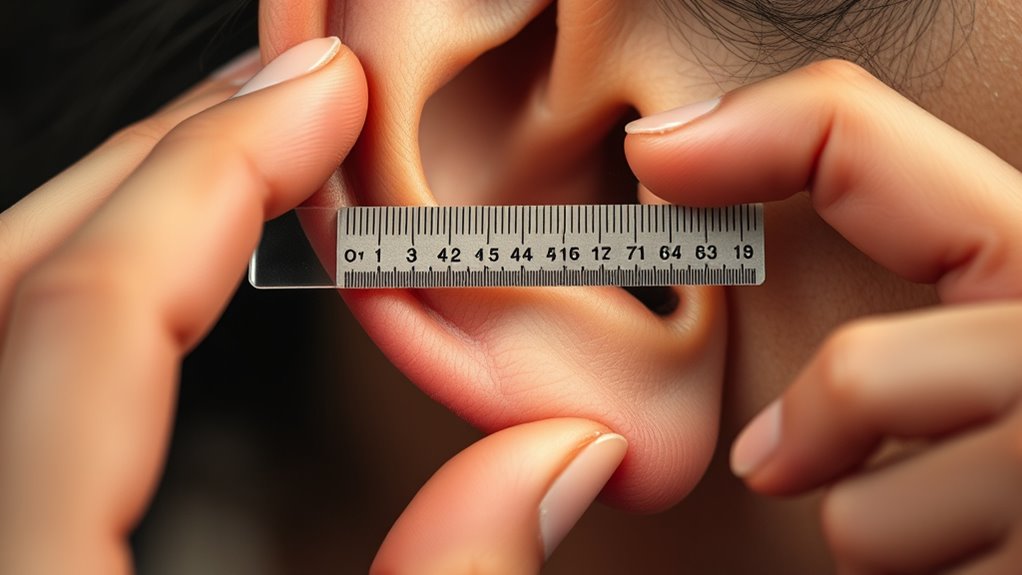
Have you ever considered stretching your ear lobes? If so, you’re probably aware that it’s a gradual process that requires patience and proper technique. One of the most important aspects of stretching is understanding the healing process, which plays a vital role in guaranteeing your ears stay healthy and avoid complications. When you start stretching, your body needs time to adapt to the new size, so rushing can lead to tearing, scarring, or infection. That’s why patience is key—allowing your ears to heal fully between stretches helps prevent damage. The healing process varies from person to person, but typically, you should wait at least four to six weeks before attempting to stretch again. During this time, your body repairs tissue and gets ready for the next size. Listening to your ears and watching for signs of irritation or excessive swelling can help you gauge whether they’re ready for the next step. If you experience pain or prolonged redness, it’s best to pause and give your lobes more time to recover.
Proper aftercare tips are essential for maintaining healthy ears and supporting a smooth healing process. After stretching, make sure to keep your ears clean and free of dirt or bacteria, which could cause infection. Use a saline solution or a gentle antiseptic recommended by professionals to cleanse the area regularly. Avoid touching your ears with dirty hands and steer clear of harsh chemicals or alcohol-based products, which can dry out or irritate the skin. Wearing jewelry that’s made from hypoallergenic materials, like surgical steel or glass, can help reduce allergic reactions and inflammation. When you’re not wearing jewelry, keep your ears free from pressure or friction, as this can hinder healing. It’s also wise to avoid swimming in pools, lakes, or hot tubs during the initial healing stage, since water can introduce bacteria and increase infection risk.
Understanding the healing process and how your body responds can help you better manage expectations and avoid setbacks. Patience and consistency in aftercare tip implementation will help your ears heal properly and reduce the risk of setbacks. You might notice some minor discomfort or swelling after a stretch, but this should fade within a few days if you follow the right aftercare tips. If you see signs of infection—such as pus, severe pain, or excessive redness—you should seek professional advice immediately. Remember, stretching is a gradual process that should be approached with care. Prioritizing your ear health by understanding the healing process and sticking to proven aftercare tips ensures your ears stay healthy and beautiful, no matter how far you want to go with your gauges.
Frequently Asked Questions
How Long Should I Wait Between Stretching Sessions?
You should wait at least 4 to 6 weeks between stretching sessions to allow proper healing. During this time, your ears recover and reduce the risk of tearing or infection. Always use safe tools and avoid rushing the process. If you notice any pain, swelling, or redness, give your ears extra time to heal before attempting to stretch again. Patience guarantees safe gauging and healthy ear lobes.
Can I Reverse Ear Gauging if I Change My Mind?
If you change your mind, reversing ear gauging is possible, but it takes patience and gentle care. Your earlobe’s elasticity plays a key role here, and you’ll want to use proper gauging techniques to avoid damage. Over time, your lobes can regain some of their original shape, but it’s a slow process—think of it as restoring a delicate piece of art. Consult a professional for best results.
What Are Common Signs of Over-Stretching or Damage?
If your ear lobes show signs of over-stretching or damage, you might notice decreased elasticity, making them feel loose or saggy. You should also watch for infection symptoms like redness, swelling, pain, or pus. These signs indicate over-stretching or damage. If you see any of these, it’s important to take care of your ears, avoid further stretching, and seek medical advice to prevent long-term injury.
Is There a Recommended Age to Start Stretching Ears?
You should wait until your earlobe development is complete before starting to stretch your ears, usually around age 18 or older. Age considerations are important because younger ears are still developing, which can increase the risk of damage. Rushing the process can lead to over-stretching or tearing. Make sure your ears are fully developed and healthy, and always follow safe gauging methods to avoid complications.
How Do I Prevent Infections During the Stretching Process?
To prevent infections during ear stretching, you should prioritize ear hygiene by washing your ears thoroughly with antibacterial soap and keeping them dry. Use only safe tools like sterilized tapers or plugs to avoid contamination. Avoid touching your ears with dirty hands, and clean your jewelry regularly with saline solution. If you notice redness, swelling, or pain, stop stretching and consult a professional to prevent complications.
Conclusion
As you carefully stretch your ear lobes, you might find it’s almost like fate guiding you to this journey. When you use safe methods, you’re not just avoiding tears—you’re discovering a new part of yourself. It’s funny how a simple decision can lead to a whole new style, almost like the stars aligned for your piercing adventure. Trust your process, stay patient, and enjoy watching your ears transform—sometimes, life’s little coincidences are the best surprises.

